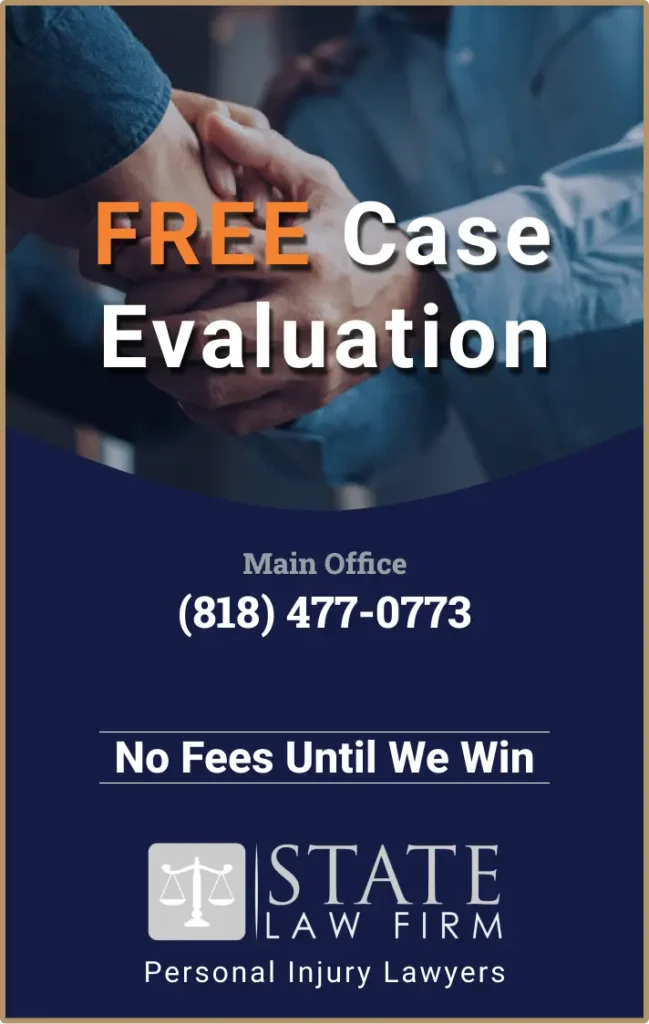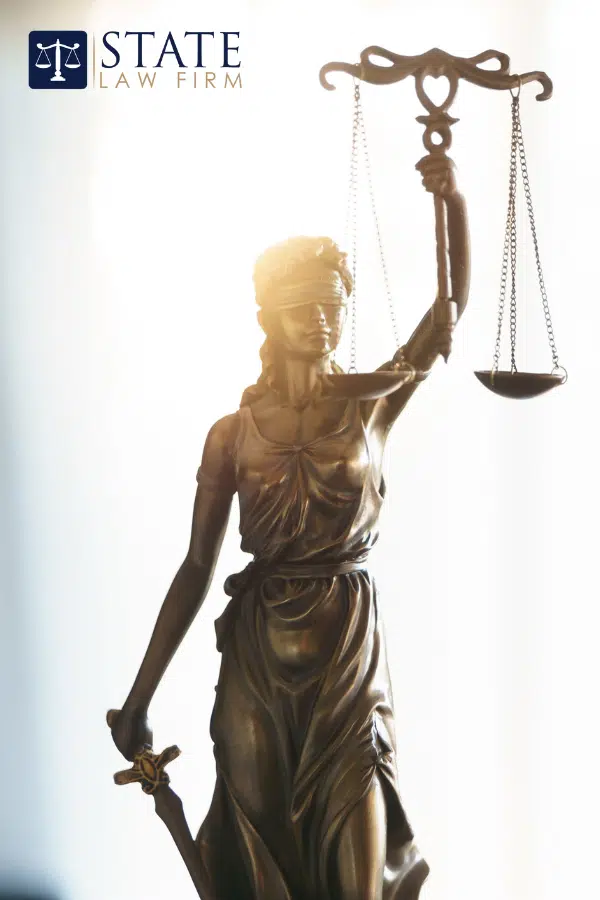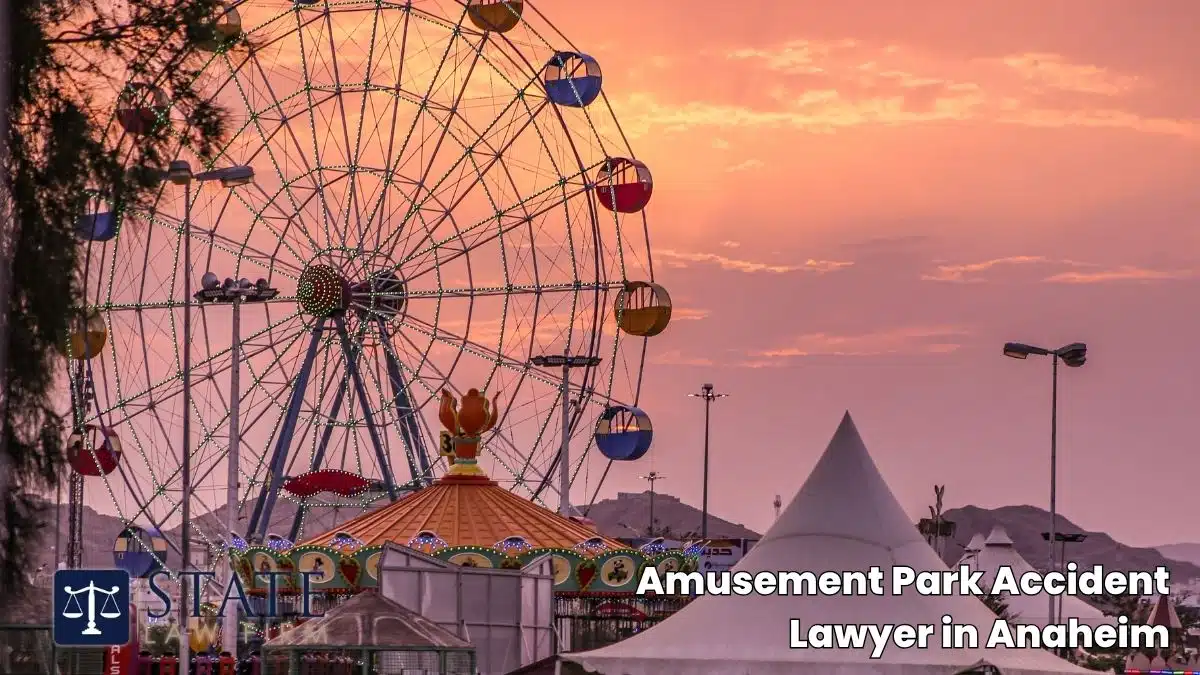
Anaheim’s Thrilling Attractions and Potential Risks: Anaheim is world-famous for its amusement parks, particularly Disneyland and Disney California Adventure, which attract millions of visitors each year. Families flock to these parks for fun and adventure, but accidents can and do happen. From high-speed roller coasters to water rides and crowded carnival games, there are many opportunities for something to go wrong. What starts as a day of joy can quickly turn into a nightmare if someone is injured due to an accident at an amusement park. In such moments, an experienced amusement park accident lawyer can be your lifeline, helping you navigate the complex legal aftermath and pursue the compensation you deserve.
In this comprehensive guide, we’ll discuss common causes of amusement park accidents, the types of injuries that can result, who may be liable, and the steps you should take after an accident. We’ll also explain how a seasoned Anaheim personal injury attorney (with over 25 years of SEO and legal insight) can assist you in seeking justice. Throughout the article, we’ll provide useful information and anchor links to relevant resources on our site for further reading on related topics.
Common Causes of Amusement Park Accidents
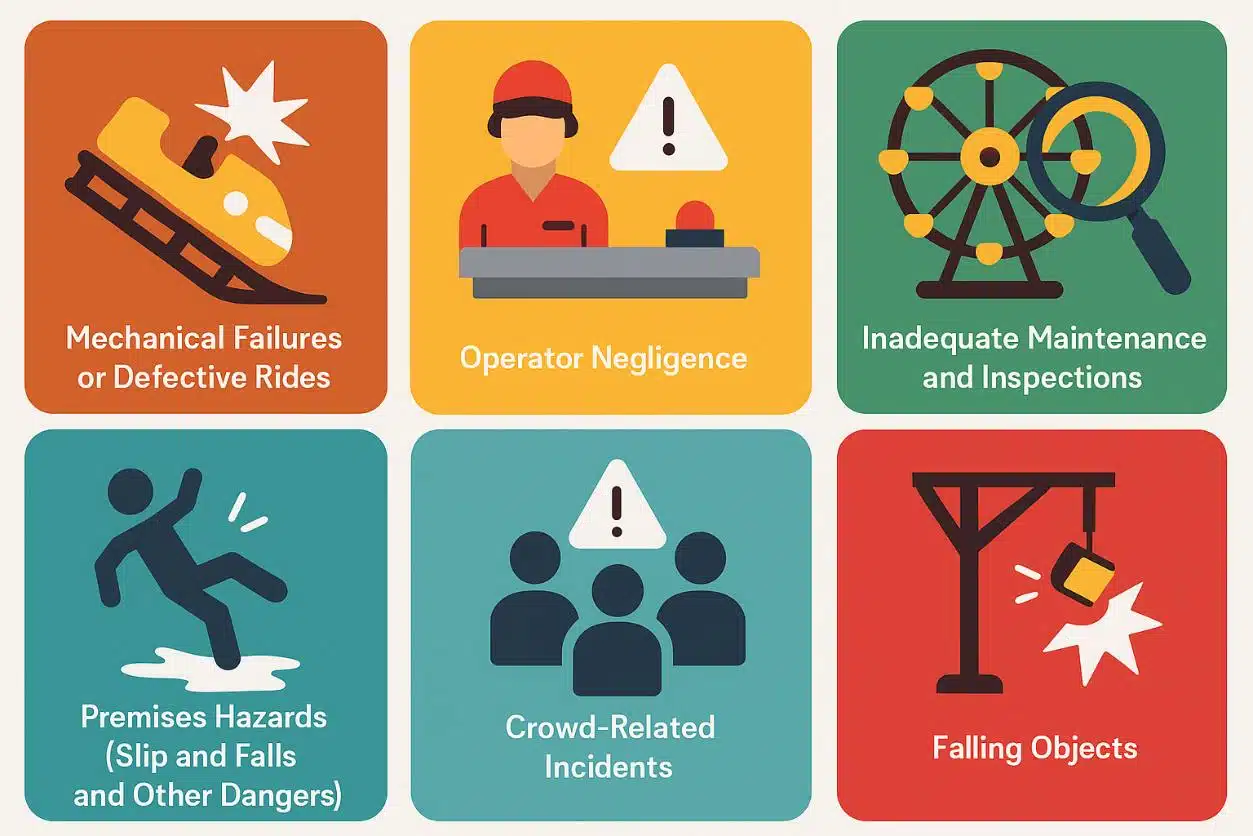
Modern theme parks are constantly pushing the envelope with faster, taller, and more thrilling rides. While these attractions are exciting, they also come with inherent risks. Here are some of the most common causes of amusement park accidents:
- Mechanical Failures or Defective Rides: A ride may malfunction due to poor maintenance, faulty parts, or defective design and product issues. For example, if a roller coaster’s safety harness fails or a carousel’s machinery breaks, riders can be seriously injured. In such cases, a product liability claim may be appropriate – holding manufacturers or maintenance companies accountable for dangerous ride defects. Our firm’s defective products lawyer can help investigate if a ride’s design or manufacturing flaw caused the injury.
- Operator Negligence: Ride operators and park staff must be vigilant and well-trained. Unfortunately, accidents often occur due to human error – such as an operator starting a ride improperly, not fastening a seatbelt correctly, or failing to shut down a ride in an emergency. Inadequate training or careless behavior by staff can lead to serious injuries. The park may be held liable for employee negligence under the concept of vicarious liability, since employers are responsible for the actions of their on-duty employees. Proper training and oversight are essential, and when parks fall short, they can be deemed negligent.
- Inadequate Maintenance and Inspections: Amusement parks in California, including those in Anaheim, are subject to regulatory inspections by agencies like Cal-OSHA (California’s Occupational Safety and Health Administration). Routine maintenance and safety inspections are critical to prevent accidents. However, if a park fails to maintain a ride, ignores known issues, or rushes through inspections, dangerous conditions can persist. For instance, a worn-out seatbelt on a ride or a crack in a track could cause an accident if not addressed. Negligent maintenance falls under premises liability, meaning the park owners failed in their duty to keep the property safe. An experienced attorney will examine maintenance logs and safety records to prove negligence if this was a factor.
- Premises Hazards (Slip and Falls and Other Dangers): Not all amusement park injuries happen on the rides. Parks are essentially large properties with restaurants, walkways, stairs, and pools, where typical accidents like slips, trips, and falls can occur. Spilled drinks, food debris, wet surfaces around water rides, uneven pavement, or poor lighting can all lead to a dangerous slip and fall accident. These incidents fall under premises liability – the legal concept that property owners (in this case, park owners) must keep their premises reasonably safe for visitors. If they knew or should have known about a hazardous condition and didn’t fix or warn about it, they can be held liable for resulting injuries. We have handled numerous premises liability cases involving theme park injuries, applying the same principles as in sidewalk falls or restaurant accidents – the key is proving negligence in maintaining a safe environment.
- Crowd-Related Incidents: Popular parks like Disneyland often have large crowds, especially during holidays or special events. Overcrowding can lead to tramplings, pushing incidents, or even assaults. In some cases, insufficient crowd control or negligent security can cause injuries. For example, a lack of proper barriers during a parade or fireworks show might result in guests being knocked over or tripping. If park security or management fails to manage crowd safety, the park could be responsible. (In contrast, if an injury was caused intentionally by another guest – such as a fight or assault – that could lead to separate claims, possibly even criminal charges for the offender, and a civil assault and battery claim if the park’s negligence contributed to inadequate security.)
- Falling Objects: Amusement parks have many moving parts – literally. Items can fall from rides (a loose bolt or even a patron’s unsecured phone) or from structures. If a park fails to secure loose objects or doesn’t design rides to contain debris, visitors below could be struck and injured. These scenarios might also fall under premises liability or product liability depending on what fell and why.
- Traveling Fairs and Carnivals: Aside from permanent theme parks, Anaheim and Orange County also host seasonal carnivals and the Orange County Fair. These traveling amusements can pose extra risks because rides are assembled and disassembled quickly as they move from city to city. Safety inspections at fairs can be less rigorous or consistent, leading to mechanical issues. If you were injured at a fair or carnival due to a ride collapse or malfunction, you still have the right to seek compensation. The challenge is identifying the liable party – it could be the ride owner, the event organizer, or a maintenance contractor. An attorney experienced in premises liability and product defect claims will know how to pursue these complex cases.
Types of Injuries in Theme Park Accidents
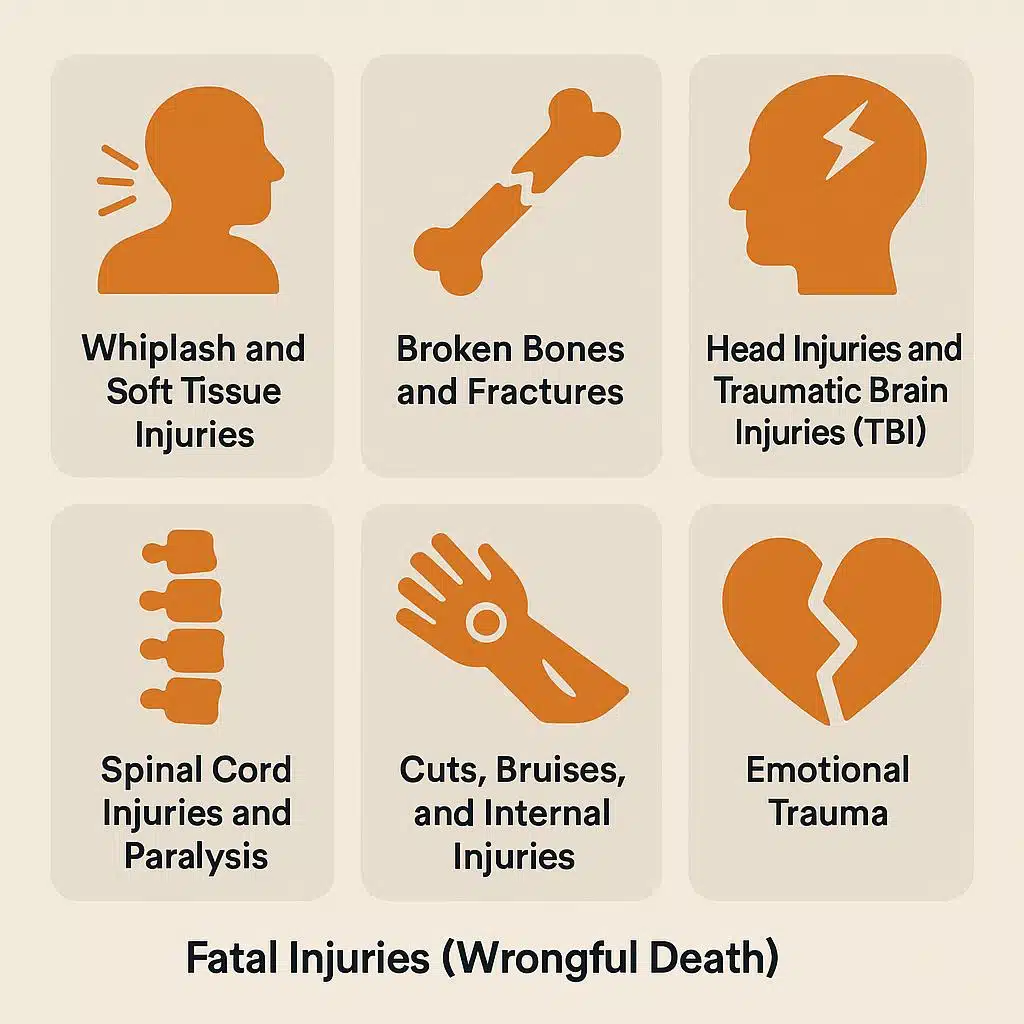
Amusement park accidents can range from minor to catastrophic. Here are some common injuries that visitors (and even park employees) might suffer:
- Whiplash and Soft Tissue Injuries: Sudden jolts or stops on a ride can cause whiplash, sprains, and strains. These soft tissue injuries may not be immediately visible but can lead to pain and mobility issues. In fact, something as seemingly minor as whiplash can be serious – our article on is whiplash a serious injury explains the potential long-term effects and why you shouldn’t dismiss these injuries.
- Broken Bones and Fractures: High-impact forces (like a rough roller coaster ride or a fall from a height) can result in broken arms, legs, or collarbones. Even stepping wrong off a ride exit or tripping on a hazard could lead to a fracture. Broken bones often require casts, and in severe cases, surgery and rehabilitation.
- Head Injuries and Traumatic Brain Injuries (TBI): A blow to the head from a ride restraint, a fall, or flying debris can cause a concussion or more severe brain injury. Traumatic brain injuries are among the most serious outcomes; they can lead to long-term cognitive impairment, memory loss, or even permanent disability. It’s especially heartbreaking when a child suffers a head injury at a theme park. Our resources on childhood head injury long-term effects and long-term effects of TBI shed light on how these injuries can impact someone’s life forever. If you or a loved one sustained a head injury at an amusement park, it’s critical to get both immediate medical care and legal advice on how to proceed, given the potentially high stakes of such an injury.
- Spinal Cord Injuries and Paralysis: In extreme accidents – for instance, a major ride derailment or a severe fall – a person could suffer damage to the spinal cord. This might result in partial or complete paralysis (paraplegia or quadriplegia). These are catastrophic injuries that change a victim’s life in an instant. The costs of lifelong care, medical equipment, and home modifications can be immense. Our firm has dedicated paralysis injury lawyers and experience with other catastrophic injuries like amputations (loss of limb) and internal organ damage. We understand how to document these injuries and fight for maximum compensation, including long-term care and loss of enjoyment of life.
- Cuts, Bruises, and Internal Injuries: Not all injuries are outwardly visible. A violent ride malfunction might cause internal injuries (such as organ damage or internal bleeding) even if there are no broken bones. Patrons can also suffer deep lacerations or severe bruising from sharp edges, broken ride components, or being thrown against barriers.
- Emotional Trauma: Surviving a terrifying incident at a theme park can leave psychological scars. It’s not uncommon for victims (especially children) to develop anxiety, PTSD, or nightmares after a serious accident. While these emotional distress injuries are not visible, they are very real and compensable. In California, you can pursue damages for mental anguish and emotional suffering as part of a personal injury claim. (If you’re wondering how that works, see our guide on how to sue for emotional distress.) An amusement park accident lawyer will ensure that pain and suffering – both physical and mental – are factored into your claim. Our resource on proving pain and suffering explains the types of evidence used to demonstrate these intangible losses.
- Fatal Injuries (Wrongful Death): Tragically, some amusement park accidents result in death. Whether due to an ejection from a ride, a structural collapse, or any other catastrophic failure, losing a loved one at what should have been a happy outing is devastating. These cases may lead to a wrongful death claim by the family of the victim. An experienced attorney can guide families through the process of a wrongful death lawsuit, seeking compensation for funeral expenses, lost future income, and the immense loss of companionship. If you have suffered such a loss, our wrongful death lawyers are here to help you understand your rights and pursue justice for your family.
Liability and Legal Considerations in Amusement Park Injuries
Determining liability – who is legally responsible – is a critical aspect of any amusement park accident case. These cases can be complex because multiple parties might share blame. Here are the key legal considerations and who might be held liable:
- Park Owners/Operators: In most cases, the primary responsibility falls on the amusement park owners or the company operating the park (for example, Disney Parks & Resorts for Disneyland). Park owners owe a duty of care to their guests. Under California premises liability law, owners must maintain their property in a safe condition and warn of any hazards that visitors are unlikely to spot on their own. If an accident happened because the park failed to meet this duty – such as not fixing a known issue on a ride, not training staff properly, or not posting warning signs – the park can be held liable for negligence.
- Ride Manufacturers or Maintenance Contractors: Sometimes an accident isn’t directly the park’s fault but rather the result of a manufacturing or design defect in the ride, or shoddy work by a maintenance contractor. For example, if a ride’s lap bar was poorly designed and tends to unlatch under certain conditions, the manufacturer of that ride could be liable under product liability law. Or, if the park outsourced maintenance to a third-party company that failed to replace a critical part, that company could share responsibility. In cases of defective rides or equipment, a skilled lawyer will often pursue claims against multiple parties – the park and the manufacturers – to cover all bases. This requires careful investigation and often expert analysis of the ride’s mechanics.
- Individual Employees: If a specific employee’s negligence caused the injury (say, a ride operator who was drunk or distracted), that person might be individually negligent. However, as noted earlier, the doctrine of vicarious liability typically means the employer (the park) is on the hook for employee negligence that occurs in the scope of their job. The exception might be if the employee was acting completely outside the scope of employment (for instance, a rogue employee intentionally harming someone, which veers into criminal territory). In most injury cases, you’ll be dealing with the park’s insurance and legal team, not suing an employee personally.
- Comparative Negligence (Is the Victim Ever at Fault?): California follows a system of comparative negligence. This means that if the injured person was partially responsible for the accident, their compensation can be reduced by their percentage of fault. Parks and their insurers might argue that you “assumed the risk” by going on a thrill ride or that you failed to follow safety instructions (like standing up when you shouldn’t have, or not using provided seatbelts correctly). While it’s true that riders accept some inherent risks, that does not absolve a park of liability for negligence. For example, if a safety harness fails, it’s not the rider’s fault for getting on – it’s the park’s duty to ensure their equipment works. Even if you did something like ignore a warning sign, you might still recover damages, just reduced by your share of fault. An amusement accident lawyer’s job is to counter unfair blame-shifting and present evidence that the majority of fault lies with the park or other defendants.
- Waivers and Disclaimers: You might recall seeing fine print on the back of your theme park ticket or posted at the entrance that seems to disclaim liability for injuries. Many parks include language that visitors assume all risks of attending. However, under California law, these disclaimers cannot waive liability for gross negligence or willful harm. Parks cannot contract out of their basic duty to keep patrons safe from unreasonable risks. So while these waivers can create legal hurdles, they are not ironclad shields. Do not be discouraged by a ticket disclaimer – if the park was negligent, you can still have a case. An experienced lawyer will know how to address waiver issues. We cover the nuances of such liability waivers and visitor rights in our article on theme park injury visitor rights in California – a recommended read if you’re worried that you “signed your rights away” by entering the park.
- Statute of Limitations: Keep in mind that California has a statute of limitations for personal injury cases. In most situations, you have two years from the date of the accident to file a lawsuit for injuries. If you miss that deadline, you could be barred from recovery. (There are some exceptions – for instance, claims against a government entity might have a much shorter deadline, and minors have a longer time in some cases – but don’t rely on exceptions.) It’s crucial to act promptly, not only because of legal deadlines but also because evidence can disappear. Video footage might be erased, witnesses forget details, and physical evidence can get lost. Contacting a lawyer soon after the incident helps ensure that an investigation can begin while evidence is fresh.
What to Do After an Amusement Park Accident
If you or a loved one is injured at an amusement park in Anaheim (or anywhere), taking the right steps immediately can protect your health and your potential legal claim. Here’s what we recommend you do in the aftermath of an accident:
- Seek Medical Attention: Your health comes first. If you’ve been hurt, see a doctor right away. For serious injuries, have someone call 911 or visit the emergency room. Even if injuries seem minor (like a headache or soreness), get a medical evaluation as soon as possible. Some injuries, such as concussions or internal injuries, might not show obvious symptoms at first but can worsen over time. Prompt medical records also document that the injury was caused by the accident, which is important for any future claim.
- Report the Incident: Notify park officials and ask to have the incident documented in an official report. Most large parks like Disneyland have procedures for handling guest injuries. Ensure that the report includes details of what happened and the names of any employees involved. Ask for a copy of this incident report if possible, or at least get a reference number or the name of the manager who documented it. If security or police are involved (for example, in a major accident or a criminal incident), cooperate with them and get their contact information too.
- Gather Evidence (if you can safely do so): If you are in a position to collect some evidence, do it. Take photos or videos of the scene, the ride or area where it happened, and any visible hazards (e.g., a broken seatbelt, a wet floor with no warning sign, etc.). If there were witnesses – other park guests who saw what happened – try to get their names and phone numbers. Eyewitness testimony could be very helpful later. Also, keep any relevant documents, like your ticket or receipt (this can help prove you were there on that date), and of course, save all medical records and bills related to your injury.
- Avoid Giving Detailed Statements or Signing Anything (Yet): After an accident, park management or insurance representatives might ask you to give a written or recorded statement about what happened. They might even offer you some form of compensation or have you sign waivers. Be cautious: at this early stage, you might not know the full extent of your injuries or the cause of the accident. It’s often wise not to sign any settlement offers or waivers, and not to give any detailed statements until you have legal counsel. Politely decline or say that you need to consult with your attorney first. Remember, insurance adjusters (even those from big companies like Disney’s insurers or third-party insurers for ride operators) may seem friendly, but their job is often to minimize the payout. For tips on dealing with insurance, see our post on handling insurance adjusters – while that one discusses GEICO and car accidents, many principles apply similarly to any insurance scenario.
- Contact an Experienced Amusement Park Accident Lawyer: As soon as possible, reach out to a qualified personal injury lawyer who has experience with amusement park or premises liability cases. The legal issues in these accidents can be complicated – from determining liability among multiple parties to negotiating with powerful corporate insurers. An attorney will guide you on your rights, handle communications with the park and insurers, and start investigating the incident thoroughly. Most importantly, a lawyer will fight to ensure you get fair compensation for all your damages (medical bills, lost income, pain and suffering, and more). Initial consultations are usually free, so you have nothing to lose by getting legal advice. (Our firm offers a free consultation to review your case and discuss your options.)
- Keep Records and Follow Through with Treatment: Maintain a file of all documents related to the accident: medical reports, prescription receipts, correspondence from the park or insurance, etc. Follow your doctor’s treatment plan and attend all follow-up appointments. Not only is this crucial for your recovery, but it also shows that you are taking your health seriously – gaps in treatment might be used by the defense to argue you weren’t badly hurt. Additionally, start a journal to record how the injury affects your daily life – note your pain levels, mobility issues, missed activities, emotional struggles, etc. This personal log can serve as evidence of your day-to-day pain and suffering during recovery.
By taking these steps, you not only protect your well-being but also strengthen your potential legal claim. The period immediately after an accident can be chaotic and stressful, but remembering to gather information and avoid common pitfalls (like quick insurance settlements) can make a big difference later on.
How an Amusement Park Accident Attorney Can Help
Navigating the aftermath of an amusement park injury on your own can be overwhelming. These cases often involve powerful companies (like Disneyland’s corporate entity or large insurance firms) and complex legal issues. Here’s how an experienced Anaheim amusement accident attorney – such as our team at State Law Firm – can make a difference in your case:
- Investigation and Evidence Gathering: A skilled lawyer will immediately start investigating the accident. This may involve obtaining maintenance records for the ride, safety inspection reports, surveillance camera footage from the park, and any prior incident reports of similar accidents. We might bring in expert engineers or safety inspectors to examine the ride for defects or review what went wrong. If needed, we’ll also interview witnesses and even park employees (sometimes former employees) to get the full picture. This thorough approach is crucial to building a strong case, whether it’s proving a mechanical failure or demonstrating that the park had notice of a dangerous condition and failed to act.
- Determining Liability and Legal Strategy: As discussed, multiple parties could be liable (park, manufacturers, contractors). We will identify all potential defendants to ensure you have the best chance of full compensation. For example, if it appears the accident was caused by both operator error and a design flaw, we might pursue a negligence claim against the park (for the operator’s actions) and a product liability claim against the manufacturer. Each type of claim has nuances – product liability doesn’t require proving negligence, just that the product (ride) was defective and unreasonably dangerous. Our attorneys are well-versed in these legal strategies. We also handle cases involving gross negligence, which could open the door to punitive damages (extra damages intended to punish especially reckless behavior). For instance, if a park knowingly ignored a serious safety issue, a court might award punitive damages to the victim. We will explore every avenue to maximize your recovery.
- Dealing with Insurance Companies and Opposing Counsel: Amusement park operators often have robust insurance policies and aggressive legal teams. It’s not unusual for them to initially deny responsibility or offer a lowball settlement hoping you’ll just accept it and go away. Our role as your advocate is to handle all communications with these insurers and lawyers. We will present the evidence of fault clearly and push back against any attempts to minimize your claim. With our firm’s experience, we know the tactics insurance companies use to reduce payouts, and we counter them effectively. Whether it’s by negotiating a fair settlement or taking the case to court, our focus is on protecting your rights and getting what you are owed. (It’s worth noting that very few personal injury cases actually go all the way to trial – most settle beforehand. However, being ready and willing to litigate often leads to better settlement offers. We prepare each case thoroughly as if it will go to trial, which puts pressure on the other side.)
- Calculating Your Damages: An attorney helps ensure that all your damages are accounted for. This includes obvious costs like medical bills (hospital stays, surgeries, rehabilitation, medication) and lost wages from time off work. But it also includes less obvious losses: future medical expenses (if you’ll need ongoing therapy or future surgery), reduced earning capacity (if you cannot return to your old job or work the same hours), and non-economic damages like pain, suffering, and mental anguish. We work with medical professionals, vocational experts, and economists when necessary to project the lifetime impact of your injury. For example, if you suffered a TBI or spinal injury, you might need a life care plan outlining future costs for care and assistance. We leave no stone unturned because once you settle or win your case, you can’t go back and ask for more – the compensation needs to cover past, present, and future losses.
- Guiding You Through the Legal Process: The legal process can be confusing. There’s paperwork, court filings, deadlines, and procedural rules to follow. As your lawyers, we handle the legal heavy lifting so you can focus on healing. We will keep you informed at every step, explaining your options and what to expect. Whether it’s making a personal injury demand letter to initiate negotiations or filing a lawsuit and going through litigation steps like discovery and depositions, we manage it all. (For those interested in how a case progresses, our blog on the litigation timeline offers a general overview of what happens when a personal injury case goes to court.) Our aim is to make the process as smooth as possible for you, reducing stress during an already difficult time.
In summary, having a knowledgeable lawyer leveled against the park’s legal team evens the playing field. You gain a fighter who knows the law, the tricks of the defense, and the fair value of your claim. With decades of experience in personal injury law, including amusement park accidents, our team has the insight to anticipate challenges and the skills to overcome them.
Pursuing Compensation: What Can You Recover?
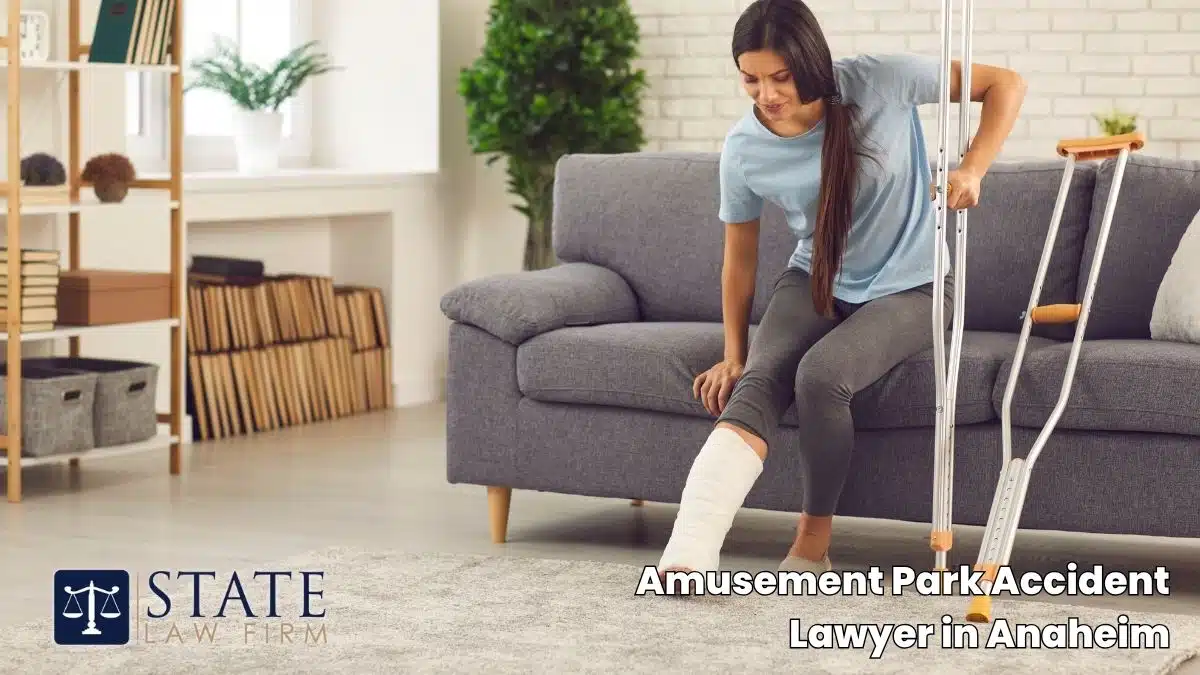
Victims of amusement park accidents in Anaheim can seek various forms of compensation (damages) through a personal injury claim or lawsuit. The goal is to make you “whole” for what you’ve suffered, to the extent money can do so. Here are the primary types of damages you may be entitled to recover:
- Medical Expenses: This includes all costs related to treating your injuries. Emergency room bills, hospital stays, surgery, doctor visits, prescription medications, medical devices (braces, wheelchairs, etc.), physical therapy, and any specialized care. Keep receipts and bills for everything. If your injury will require future medical care (for example, ongoing therapy or periodic future surgeries), those estimated future costs should be included as well. Medical bills can be astronomical, especially for serious injuries like spinal cord damage or brain injuries, so this often forms a large part of the claim.
- Lost Wages and Loss of Earning Capacity: If you had to miss work because of your injury or recovery, you can claim the income you lost. This includes not just salary, but also lost overtime, bonuses, or sick/vacation days you had to use. If your injuries are severe enough to affect your ability to work in the future (say you cannot return to your previous job or you can only work part-time), you may also recover for loss of earning capacity. We would work with economic experts to calculate how much income you are likely to lose over your lifetime due to the injury. For example, if you were a construction worker and a spinal injury prevents you from doing physical labor, the difference between your old potential earnings and what you can do now becomes part of your claim.
- Pain and Suffering: These are non-economic damages for the physical pain and emotional suffering you’ve endured. There’s no exact dollar for pain and suffering, but factors include the severity of the injury, how long your pain is expected to last, and how it impacts your daily life. For instance, a person who has chronic back pain and can no longer enjoy activities they once did will have a significant pain and suffering component. California does not cap pain and suffering damages in most personal injury cases (the way it does in some medical malpractice cases), so you are entitled to seek a fair amount that reflects your experience. We often present testimony from you, family members, or even mental health professionals to illustrate the extent of your suffering.
- Emotional Distress and Mental Anguish: Separate from general pain and suffering, if you have diagnosable psychological effects – such as PTSD, depression, anxiety – as a result of the accident, these mental health injuries are compensable. If you’ve seen a therapist or psychiatrist, those treatment costs can be recovered too. The law recognizes that serious accidents aren’t just physical events; they can leave deep emotional scars, especially when someone goes through a harrowing experience like a ride malfunction or witnessing a loved one’s injury.
- Permanent Disability or Disfigurement: If the accident left you with a permanent disability (such as paralysis, limb loss, vision or hearing impairment) or visible scars/disfigurement, these are significant damages. They affect your quality of life, your independence, and sometimes how others treat you. Juries tend to acknowledge the life-altering nature of such injuries with higher compensation. Also, costs for prosthetics, mobility aids, home modifications (like wheelchair ramps), and personal care assistance can be included in the economic damages.
- Loss of Consortium: If your injuries have affected your relationship with your spouse or family – for example, you can no longer provide the companionship, affection, or intimacy you did before – your spouse may have a claim for loss of consortium. This is a derivative claim that recognizes the impact on the family unit. While not every case involves this, it is something to discuss with your attorney if applicable (our blog on loss of consortium in personal injury cases provides more insight).
- Wrongful Death Damages: In the unfortunate event that a family member was killed in an amusement park accident, the surviving family can seek wrongful death damages. In California, this can include funeral and burial expenses, the financial support the deceased would have provided, the loss of their love, companionship, and guidance, and sometimes punitive damages if egregious negligence was involved. While money can never replace a life, these damages help families cope with the financial fallout and hold the negligent party accountable. For more details on what’s recoverable, see our overview of wrongful death claims in California.
- Punitive Damages: These are not awarded in every case – only where the defendant’s conduct was especially reckless, malicious, or egregious. In an amusement park context, imagine a scenario where a park knew a ride had a serious safety defect that had injured people before, but they kept it running without fixes. That kind of behavior might warrant punitive damages to penalize the company and deter similar conduct in the industry. California sets a high bar for punitive damages, but they are possible. If applicable, we will pursue them (as noted, see our punitive damages guide for how these work in California personal injury cases).
Every case is unique. The key is that an experienced attorney will identify all possible damages and back them up with solid evidence and documentation. We don’t want you to settle for less than you need or deserve. It’s our job to present a compelling case for why the defendants owe you a full and fair amount for everything you’ve been through.
Why You Need a Local Anaheim Personal Injury Lawyer
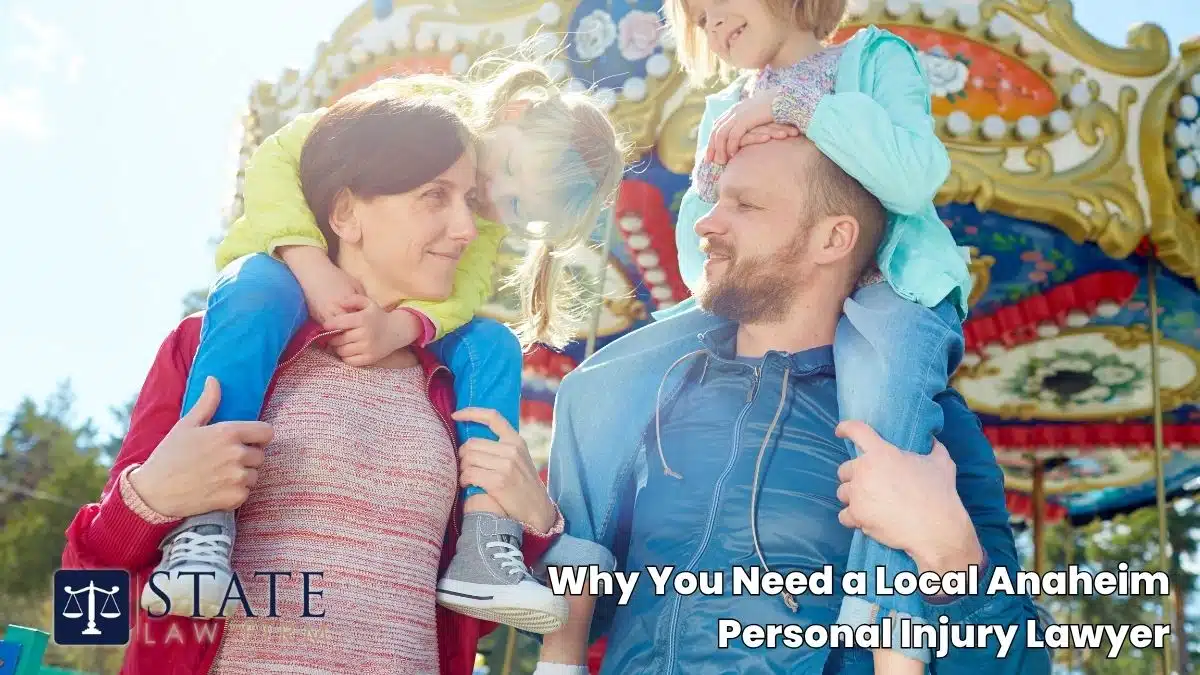
After an amusement park injury in Anaheim, you may wonder if you need a lawyer from the local area or if any personal injury attorney will do. While any qualified personal injury lawyer can technically handle these cases, there are distinct advantages to choosing a firm familiar with Anaheim, Orange County, and Southern California courts and circumstances:
- Knowledge of Local Attractions and Regulators: A local attorney understands the environment of places like Disneyland, Disney’s California Adventure, Knott’s Berry Farm (nearby in Buena Park), and other Southern California parks. We know their layouts, their typical operations, and even some history of past incidents. Additionally, we are familiar with California’s safety regulations for amusement rides – including the role of Cal-OSHA in inspecting rides. This local insight helps in both investigating your case and arguing it effectively. For instance, if we know that a particular ride has a reputation for jerky stops that cause whiplash, or that a certain park has had maintenance issues in the past, we can dig deeper into those angles.
- Proximity for Investigation: Being local means we can promptly visit the scene of the accident if needed. We can take photographs, inspect the location, and even recreate conditions if appropriate. Time is often of the essence in an investigation – evidence like skid marks on a ride track or a hazard on a walkway might be fixed or cleaned up soon after. Our ability to be on-site quickly can preserve critical evidence. We also know where and how to obtain local incident reports, and if necessary, we can file subpoenas or court orders in nearby jurisdictions without delay.
- Experience with California Law and Courts: Every state’s laws are a bit different. Our firm is well-versed in California personal injury law – from nuances of comparative negligence to specific statutes that might apply (for example, if an accident happened on a state or county fairground, certain government claim rules could kick in). We also have experience dealing with Orange County courts and even juries. If your case goes into litigation in Orange County Superior Court, it helps that your attorney knows the local court rules, the judges, and the jury pool tendencies. We can tailor our strategies to what works effectively in our area.
- Resources and Reputation: State Law Firm (our firm) has built a strong reputation over years of serving clients in Los Angeles, Orange County, and throughout California. We have the resources to take on big cases – including amusement park accidents which can be expensive to litigate due to expert witness needs and extensive discovery. Our successful track record in personal injury cases (see some of our case studies for examples of how we’ve helped past clients) means the insurance companies know we don’t back down. We have also earned the trust of the community, as evidenced by our client testimonials. Hiring a respected local firm can sometimes encourage defendants to offer a fair settlement, because they know we’re prepared and able to fight effectively on our home turf.
- Personalized Attention and Understanding: As local attorneys, we are part of the community. We genuinely care about making our area – including its beloved theme parks – safer. When a client from Anaheim comes to us after a Disneyland accident, we understand the shock and betrayal they might feel (“How could a place of joy cause such harm?”). We approach each case with compassion and treat our clients like family. You won’t be just another case number. We’ll take the time to listen to your story, answer your questions (no matter how many), and keep you updated. Our goal is not only to win your case but also to support you through the recovery process. That level of commitment is something you’re more likely to find with a dedicated local firm than a faceless national lawyer mill.
In summary, working with an Anaheim-area amusement accident lawyer ensures you have someone by your side who understands the local context and has the resources to take on big entities. We combine big-firm expertise with small-firm personalized service – the best of both worlds for our clients.
Put 25+ Years of Experience on Your Side (Call for a Free Consultation)
If you or a loved one has been injured at an amusement park in Anaheim, don’t navigate this complex situation alone. The aftermath of such an accident can be physically, emotionally, and financially draining. From dealing with medical appointments to handling calls from insurance adjusters, it’s a lot for anyone – especially when you should be focusing on healing. That’s where we come in.
At State Law Firm, we have decades of experience in personal injury law. Our team has seen it all – from car wrecks and rideshare accidents to premises liability cases and catastrophic injuries. We bring the full breadth of our knowledge to each case, including innovative SEO-driven research skills that help us stay on the cutting edge of legal trends and safety data. As an SEO expert with 25 years of experience would do, we’ve meticulously studied accident patterns and legal precedents to build compelling cases that insurance companies find hard to deny.
When you hire us, you get a dedicated personal injury lawyer (or team of lawyers) fighting for you. We will handle the paperwork, the evidence gathering, and the negotiations with Disneyland’s legal team (or any other park’s representatives), so you can concentrate on your recovery. We operate on a contingency fee basis – which means you pay nothing upfront and no fees at all unless we win compensation for you. This policy reflects our confidence in our ability to help and ensures that everyone, regardless of financial status, can access top-tier legal representation. There’s truly nothing to lose and everything to gain by reaching out.
Contact us today for a free consultation. We’ll review the details of your amusement park accident, answer your questions, and outline a plan to pursue your claim. Our attorneys are compassionate listeners and tenacious litigators – we will give you an honest assessment of your case and then, if you choose to proceed, fight tirelessly to obtain justice for you.
Don’t let a day of fun that turned tragic define your future. With the right legal help, you can hold the negligent parties accountable and secure the resources you need to move forward. Whether your case involves a slip-and-fall at Downtown Disney, a ride malfunction on the Matterhorn, or any injury at an Anaheim amusement venue, we are here to help. Let our experience, knowledge, and dedication be the force that guides you to a brighter, safer tomorrow. Reach out to our team at State Law Firm – your trusted Amusement Park Accident Lawyer in Anaheim – and let’s get you on the path to recovery and justice.

